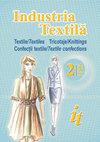薄荷提取物对功能性粘胶纤维的抗菌性能研究
IF 0.9
4区 工程技术
Q3 MATERIALS SCIENCE, TEXTILES
引用次数: 0
摘要
使用经过天然提取物处理的纤维素纤维可以杀死细菌。粘胶是一种再生纤维素纤维,具有良好的生物降解性。薄荷提取物的使用使粘胶纤维成为一种功能性纤维,它产生了有益的效果,可以用作抗菌纺织品。结果表明,薄荷提取物添加量的增加也提高了100%粘胶织物的抑菌率,对大肠杆菌和金黄色葡萄球菌的抑菌性能分别为97%和94%。对50/50棉/功能粘胶的抑菌率相对较低,即。对大肠杆菌和金黄色葡萄球菌的抑制作用分别为85%和81%。不同洗涤次数对织物抗菌性能的影响是这样的:100%功能性粘胶织物与50%混纺织物相比,洗涤5至20次后,对大肠杆菌的抗菌性能下降14%,而对金黄色葡萄球菌的抗菌性能下降15%。经过20次洗涤后,所有样品的抗菌性能均达到60%以上。与标准粘胶纤维相比,功能粘胶纤维在干燥状态下的断裂强度下降了12.9%,在潮湿状态下的断裂强度下降了14%。然而,功能性粘胶纤维的伸长率在干燥状态下提高了6.4%,在潮湿状态下提高了3.7%,导致功能性粘胶纤维的模量较低。100%功能性粘胶织物的驱蚊率为70 - 90%,而50/50混纺织物的驱蚊率为60-80%,洗涤5至20次。总体结果显示,驱蚊行为是可以接受的。采用一种简单的方法开发具有成本效益和丰硕成果的抗菌纺织品。本文章由计算机程序翻译,如有差异,请以英文原文为准。
Antimicrobial property of functional viscose fibre by using mint extract
The use of cellulosic fibres treated with natural extracts can kill bacteria. Viscose is a regenerated cellulosic fibre with
excellent biodegradability. The use of mint extract makes viscose a functional fibre, which gives beneficial results and
can be used as an antimicrobial textile. The results clearly showed that the increasing ratio of the mint extract also
increased the bacteriostatic ratio so that the antimicrobial property against E. Coli and S. Aureus for 100% viscose fabric
is 97% and 94%, respectively. The bacteriostatic ratio against 50/50 cotton/functional viscose is proportionally lower,
i.e., 85% and 81% against E. Coli and S. Aureus. The different number of washings affected the antimicrobial property
of the fabrics in such a way that: the fabric with 100% functional viscose indicated a reduction of 14% for E. Coli,
whereas the antimicrobial property decreased by 15% against S. Aureus after 5 to 20 washes as compared to the fabric
with the blend 50/50. All the samples exhibited antimicrobial property more than 60% after 20 washes. The breaking
strength of the functional viscose fibre decreased by about 12.9% in dry form and 14% in wet state compared with
standard viscose fibre. However, the elongation of functional viscose fibre improved by 6.4% in dry form and 3.7% in
the wet state, resulting in the low modulus of functional viscose fibre. The mosquito repellency rate ranges from 70–90%
against 100% functional viscose fabrics, whereas 60–80% against the fabric is made up of a 50/50 blend for 5 to
20 washes. The overall results show acceptable behaviour against mosquito repellency. A simple approach was applied
to develop antimicrobial textile products with cost-effectiveness and fruitful results.
求助全文
通过发布文献求助,成功后即可免费获取论文全文。
去求助
来源期刊

Industria Textila
工程技术-材料科学:纺织
CiteScore
1.80
自引率
14.30%
发文量
81
审稿时长
3.5 months
期刊介绍:
Industria Textila journal is addressed to university and research specialists, to companies active in the textiles and clothing sector and to the related sectors users of textile products with a technical purpose.
 求助内容:
求助内容: 应助结果提醒方式:
应助结果提醒方式:


